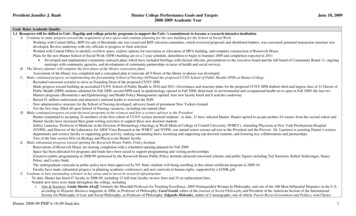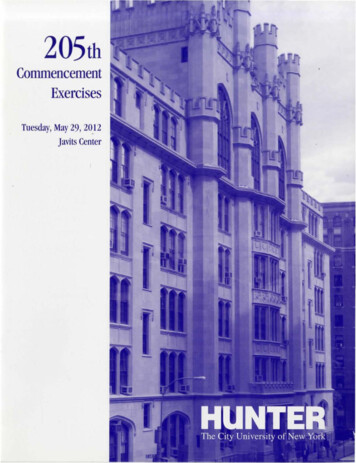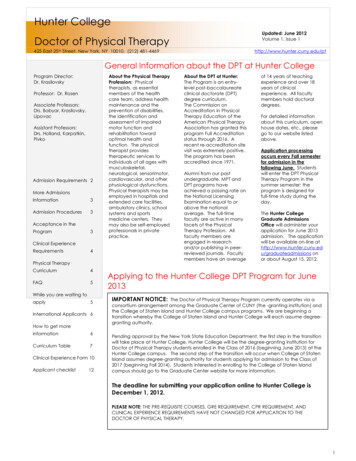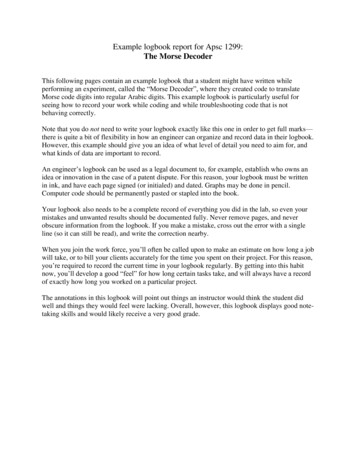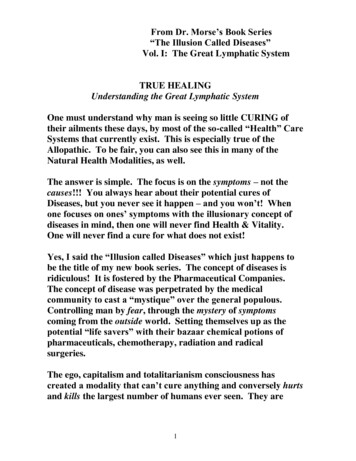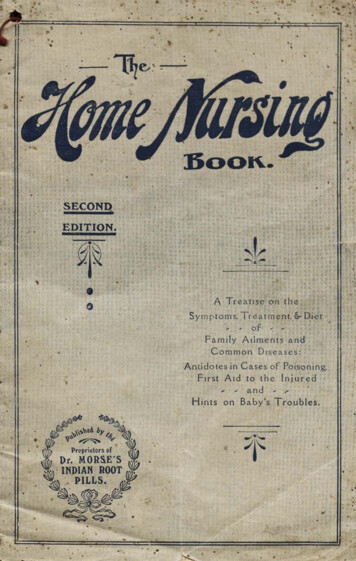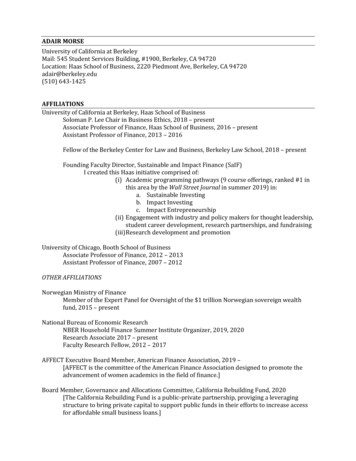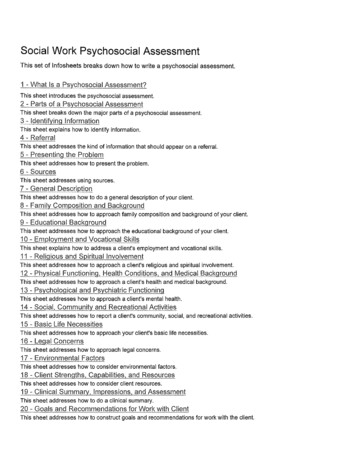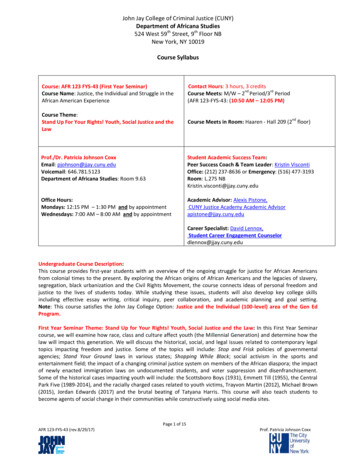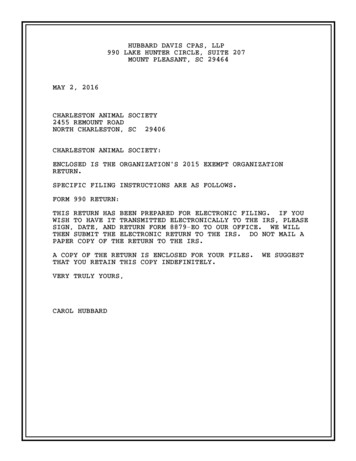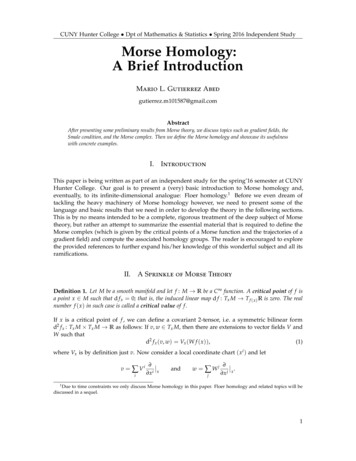
Transcription
CUNY Hunter College Dpt of Mathematics & Statistics Spring 2016 Independent StudyMorse Homology:A Brief IntroductionMario L. Gutierrez Abedgutierrez.m101587@gmail.comAbstractAfter presenting some preliminary results from Morse theory, we discuss topics such as gradient fields, theSmale condition, and the Morse complex. Then we define the Morse homology and showcase its usefulnesswith concrete examples.I.IntroductionThis paper is being written as part of an independent study for the spring’16 semester at CUNYHunter College. Our goal is to present a (very) basic introduction to Morse homology and,eventually, to its infinite-dimensional analogue: Floer homology.1 Before we even dream oftackling the heavy machinery of Morse homology however, we need to present some of thelanguage and basic results that we need in order to develop the theory in the following sections.This is by no means intended to be a complete, rigorous treatment of the deep subject of Morsetheory, but rather an attempt to summarize the essential material that is required to define theMorse complex (which is given by the critical points of a Morse function and the trajectories of agradient field) and compute the associated homology groups. The reader is encouraged to explorethe provided references to further expand his/her knowledge of this wonderful subject and all itsramifications.II.A Sprinkle of Morse TheoryDefinition 1. Let M be a smooth manifold and let f : M R be a C function. A critical point of f isa point x M such that d f x 0; that is, the induced linear map d f : Tx M T f ( x) R is zero. The realnumber f ( x ) in such case is called a critical value of f .If x is a critical point of f , we can define a covariant 2-tensor, i.e. a symmetric bilinear formd2 f x : Tx M Tx M R as follows: If v, w Tx M, then there are extensions to vector fields V andW such thatd2 f x (v, w) Vx (W f ( x )),(1)where Vx is by definition just v. Now consider a local coordinate chart ( xi ) and letv V i xiixandw W j x jjx.1 Dueto time constraints we only discuss Morse homology in this paper. Floer homology and related topics will bediscussed in a sequel.1
CUNY Hunter College Dpt of Mathematics & Statistics Spring 2016 Independent Study(We can also take W j W j / x j , where W j is now a constant function.) Then,2d f x (v, w) Vx (W f ( x )) v(W f )( x ) vso that the matrix f W x jj!j 2 f(x) xi x j(x) V i W ji,j 2 f( x ), xi x j (2)represents d2 f x with respect to the basis / x1 x , . . . , / x n x . (This matrix is known as theHessian of f .)Definition 2. We will say that a critical point x is degenerate if the bilinear form d2 f x is degenerate(i.e. if d2 f x 0); we call x nondegenerate otherwise. Moreover, we will say that a function is a Morsefunction if all its critical points are nondegenerate.Remark 1. It is clear that a critical point x is nondegenrate if and only if the matrix (2) is nonsingular(i.e. invertible).It is a fact that studying a well-chosen function on a manifold can give rather precise informationon its topology. A most instructive example is known as the "height" function f : R3 R and itsrestriction f to the different submanifolds embedded (or immersed) in R3 , as presented in thefollowing figures. 1f 1In the figure above, note that for a R, the level sets of f aref 1 ( a ) if a 1, a point if a 1,a circle if 1 a 1, a point if a 1, if a 1.Each of these level sets has a well defined topology which changes exactly at the regular pointsof the function; in this case at the north pole (maximum) and the south pole (minimum) of the2-sphere. The situation is analogous for the torus T2 in the next figure, except that there are now2
CUNY Hunter College Dpt of Mathematics & Statistics Spring 2016 Independent Studycritical points that are not extrema of the function, namely the two "saddle" points b and c:af ( a)f (b)bf cf (c)f (d)dThe corresponding level sets at these saddle points b and c are curves of the form(that is,S1 S1 ), and are therefore not submanifolds (immersed or embedded). The regular, noncritical levelsets must however all be (embedded) submanifolds because of the regular level set theorem.2Let T2a be the set of all points x T2 such that f ( x ) a. Then we have the following: D2 2 S1 I (a cylinder)Ta T2 r D̊2 T2if a f (d),if f (d) a f (c),if f (c) a f (b),if f (b) a f ( a),if a f ( a).Remark 2. In order to describe the changes in the topology of T2a as a passes through the critical values off , it is convenient to consider homotopy type rather than homeomorphism type (for a somewhat detaileddiscussion the reader is referred to [MJ]).Now let us take a second look at the "height" function on the 2-sphere, although this time weconsider a "deformed" sphere, which we denote by S2 . Obviously, S2 is still diffeomorphic to S2 ,but the function now has two local maxima and a saddle point:af ( a)f (c)cbdf f (b)f (d)2 Recall that this theorem states that every regular level set of a smooth map between smooth manifolds (or of a smoothfunction to R in our particular case) is a properly embedded submanifold whose codimension is equal to the dimension ofthe codomain.3
CUNY Hunter College Dpt of Mathematics & Statistics Spring 2016 Independent StudyNote that the parity of the number of critical points of the new function is the same as that of theoriginal one (i.e., they are equal mod 2). It turns out that if we have that the critical points of ourfunction are nondegenerate (which is indeed the case for the critical points shown in our figures),then modulo 2 the number of critical points equals the Euler characteristic of the manifold, aninvariant that does not depend on the function but only on the manifold itself. However, note thatthis invariant is not especially strong:χ(S2 ) 2,χ ( T2 ) 0mod 2χ(S2 ) χ(T2 ), but it is clear that the sphere and the torus are very different manifolds even if the two admit afunction with four nondegenerate critical points (and hence the same Euler characteristic mod2). It is the concept of Witten spaces of trajectories that will allow us to present a finer invariant(known as the Morse homology HMk (V ) of a manifold V (c.f. §IV)) in the following sections.We close out this section by presenting the Morse Lemma, which is, for our purposes, the mostimportant result of Morse theory. We refer the reader to [MJ] for a proof using Hadamard’s lemma,or to [AD] for a proof that is a direct application of the implicit function theorem.Definition 3. A symmetric bilinear form g on a vector space V is said to be negative definite providedthat for v V and v 6 0, we have g(v, v) 0. The index of g on V is the largest integer that is thedimension of a subspace W V on which g W is negative definite. We will refer to the index of thesymmetric bilinear form d2 f x which we previously defined on (1) simply as the index of f at x.The Morse Lemma will show that the behavior of a function f at p can be completely described byits index:Lemma 1 (Morse Lemma). Let p M be a nondegenerate critical point for f C ( M). Then there isa local smooth chart (U, ϕ), where U is a neighborhood of p and ϕ( p) ( x1 ( p), . . . , x n ( p)) (0, . . . , 0),and such thatf ϕ 1 ( x 1 , . . . , x n ) f ( p ) νnj 1j ν 1 ( x j )2 ( x j )2 ,where ν is the index of f at p.Definition 4. A chart in whose open set the coordinates given by the Morse lemma are defined is called aMorse chart.Remark 3. An immediate result that follows from the Morse lemma is the fact that the nondegeneratecritical points of a function are isolated. This implies, in particular, that a Morse function on a compactmanifold can only have finitely many critical points.4
CUNY Hunter College Dpt of Mathematics & Statistics Spring 2016 Independent StudyIII.Pseudo-GradientsLet ( M, g) be a Riemannian manifold and recall the notion of the gradient of a function f C ( M),denoted grad f , which is given bygrad f (d f )] f gij xi x j .i,jUnraveling the definitions, we see that for any vector field X Γ ( TM), the gradient satisfiesg(grad f , X ) (grad f )[ ( X ) d f ( X ) X f .(Here we are using the "sharp" (]) and "flat" ([) operators, which are the well known musicalisomorphisms between TM and T M.) Now we have the following definition:Definition 5. Let f : M R be a Morse function on a manifold M. A pseudo-gradient field (alsoknown as pseudo-gradient adapted to f ) is a vector field V on M such that: We have d f x (Vx ) 0, where equality holds if and only if x is a critical point. In a Morse chart in the neighborhood of a critical point, V coincides with the negative gradient for thecanonical metric on Rn .This notion allows us to make the Morse charts more precise by specifying the trajectories (alsoknown as integral curves or flow lines) of a pseudo-gradient field. For example, Figure 1 shows thedifference between a maximum and a minimum critical points in a Morse chart.Figure 1: Trajectories of a pseudo-gradient field in a Morse chart at a maximum (left) and a minimum (right).Recall that a flow domain for a manifold M is an open subset D R M with the property thatfor each p M, the set D ( p) {t R (t, p) D} is an open interval containing 0. A flow onM is then a continuous map θ : D M, where D R M is a flow domain, that satisfies thefollowing group laws: for all p M, we have θ (0, p) p, and and for all s D ( p) and t D (θ (s,p))such that s t D ( p) ,θ (t, θ (s, p)) θ (t s, p).Now we make the following important definition:5
CUNY Hunter College Dpt of Mathematics & Statistics Spring 2016 Independent StudyDefinition 6. Let p M be a critical point of f C ( M). Denote by θt the associated map θt : M Mof the flow θ : D M of a pseudo-gradient. We define the stable manifold of p to be sW ( p) x M lim θt ( x ) p ,t and its unstable manifoldW u ( p) x M lim θt ( x ) p .t Remark 4. Note that with regards to stable/unstable manifolds, it only makes sense to consider D R M,i.e. we are only going to focus on global flows.Remark 5. The stable and unstable manifolds of the critical point p are submanifolds of M that arediffeomorphic to open disks. Moreover, we havedim W u ( p) codim W s ( p) Ind( p),where Ind( p) denotes the index of the point p as a critical point of f .To illustrate the concept of stable/unstable manifolds, here is a very simple example. Consider the2-sphere S2 with the height function f described earlier. Let p be the minimum (south pole) andlet q be the maximum (north pole). Then, for any pseudo-gradient field, we haveW s ( p ) S2 r { q } ,W u ( p ) { p },and similarlyW s ( q ) { q },W u ( q ) S2 r { p } .The most important property of the trajectories of a vector field is that they all connect criticalpoints of a function: all trajectories come from a critical point and go towards another criticalpoint:Proposition 1. Suppose that M is a compact manifold. Let γ : R M be a trajectory of the pseudogradient field V. Then there exist critical points c and d of f C ( M) such thatlim γ(t) ct andlim γ(t) d.t Proof. A proof can be found on [AD, 28-29].Now we are finally arriving at the main result of this section. First let us recall that on a manifoldM two embedded submanifolds S, S0 M are said to intersect transversely if for each p S S0 ,the tangent spaces Tp S and Tp S0 together span Tp M (where we consider Tp S and Tp S0 as subspacesof Tp M). We denote the intersection of two submanifolds S, S0 that meet transversally as S t S0 .6
CUNY Hunter College Dpt of Mathematics & Statistics Spring 2016 Independent StudyDefinition 7. A pseudo-gradient field adapted to the Morse function f is said to satisfy the Smalecondition if all stable and unstable manifolds of its critical points intersect transversally, that is, if for allcritical points p, q of f , we haveW u ( p ) t W s ( q ).Remark 6. Certain stable and unstable manifolds always meet transversally. For example, we always have: W u ( p) t W s ( p) (for the same critical point p), which is what we see in a Morse chart around p. W u ( p) W s (q) if p and q are distinct and f ( p) f (q) (in particular, these stable and unstablemanifolds are transversal).If the vector field satisfies the Smale condition, then for all critical points p and q, we havecodim(W u ( p) W s (q)) codim W u ( p) codim W s (q);that is,dim(W u ( p) W s (q)) Ind( p) Ind(q).Under our condition, this intersection W u ( p) t W s (q) is a submanifold of M, which we willdenote by M( p, q). It consists of all points on the trajectories connecting p to q: M( p, q) x M lim θt ( x ) p and lim θt ( x ) q .t IV.t Morse HomologyRecall that a chain complex is a sequence C of modules endowed with linear maps : Ck Ck 1that satisfy 2 0. Now let C and D be complexes of Z2 -vector spaces. Then their tensorproduct is the complex defined by(C D )k i j k Ci D jwith boundary operator DCD C(c d) ( c) d,c ( d)jik Ci 1 D j Ci D j 1 ( C D ) k 1for c d Ci D j (C D )k .It can be shown then that the homology of the tensor product complex is the tensor product of thehomologies; i.e., H (C D ) H (C ) H ( D ) (see [AD, Proposition B.11, Pg 556]).Now, letting Critk ( f ) denote the set of critical points of index k of a function f , we define thevector space Ck ( f ) αp α Zpp2 . p Crit(f)k7
CUNY Hunter College Dpt of Mathematics & Statistics Spring 2016 Independent StudyIn other words, for every integer k, we let Ck ( f ) be the Z2 -vector space generated by the criticalpoints of index k of f (we will often denote this simply by Ck when there is no risk of confusion).Using the connections between critical points established by the trajectories of a generic (that is,satisfying the Smale condition) pseudo-gradient field V, we define maps V : Ck Ck 1 .In order to define such map V on Ck ( f ), it suffices to know how to define V ( p) for a criticalpoint p of index k. This must be a linear combination of the critical points of index k 1: V ( p ) ηV ( p, q)qwith ηV ( p, q) Z2 .q Critk 1The idea is to define ηV ( p, q) as the number (modulo 2) of trajectories of V going from p to q. Wewill show later on that this number is indeed finite.Let us now employ these ideas on the examples previously shown on Section §II: The Height on the Round Sphere: Here, C0 Z2 , with generator a, C1 0 and C2 Z2 , withgenerator b (refer to the examples on Section §II to see what these generators are). The homologygroup is given by(Z2 if 0, 2,H 0if 6 0, 2.The same computation with the height function on the unit n-sphere in Rn 1 , which also has onlya minimum and a maximum, gives(Z2 if 0, n,H 0if 6 0, n. The "Deformed" Sphere: Now C0 Z2 , with generator a, C1 Z2 , with generator b, andC2 Z2 Z2 , with generators c and d. By counting the trajectories connecting the critical points,we find c b, d b, and b 2a 0.Thus we get H0 Z2 ,H1 0, H2 Z2 .Note that even though the complex is quite different from that of the regular sphere, its homologyis the same (as expected). The Torus: Consider the function cos(2πx ) cos(2πy) on the torus. Here C0 Z2 , withgenerator a, C1 Z2 Z2 , with generators b and c, and C2 Z2 , with generator d. Thedifferentials are d 2b 2c 0and b c 2a 0.Thus the homology modulo 2 is H0 Z2 ,H1 Z2 Z2 , H2 Z2 ,8
CUNY Hunter College Dpt of Mathematics & Statistics Spring 2016 Independent Studywhich is indeed the homology of T2 .If p and q are two critical points of a function f : M R, then we let LV ( p, q) denote the set oftrajectories from p to q of the vector field V. Similarly, the set of broken trajectories from p to q isgiven by[LV ( p, c1 ) · · · LV (cn 1 , q).LV ( p, q) ci Crit( f )(As suggested by the notation, this space is meant to be a compactification of LV ( p, q).)3Now, if p is a critical point of the Morse function f , then its stable manifold W s ( p), which isdiffeomorphic to a disk, is an orientable manifold. We then choose, for each critical point p M,an orientation for W s ( p), for which there is a corresponding co-orientation on W u ( p). Thus, if pand q are any two critical points, we have that W u ( p) t W s (q) is therefore oriented. The sameholds for its intersection with a regular level set (a regular level set is co-oriented by the transverseorientation given by the pseudo-gradient field V that is used). Hence the space of trajectoriesLV ( p, q) is also an oriented manifold.Since the homology H ( f , X ) (X being a vector field) of the Morse complex on a manifold Vdepends only on V, we denote it by HM (V; Z2 ) (for "Morse homology modulo 2" of V). Likewise,the homology of the complex taking into account orientations is denoted by HM (V; Z) (integralhomology of V).Proposition 2. If V is a compact connected manifold, then HM0 (V; Z2 ) Z2 .Corollary 1. Let V be a compact connected manifold of dimension n. Then HMn (V; Z2 ) Z2 .Both the proposition and the corollary do in fact hold over Z if we take into account orientations.The analogue of the corollary states that if V is a compact, connected, oriented n-manifold, thenHMn (V; Z) Z.Corollary 2. Let V be a compact n-manifold. Then HM0 (V; Z2 ) and HMn (V; Z2 ) are Z2 -vector spacesof dimension the number of connected components of V.Proof. Write V as the disjoint union of its connected components V qkj 1 Vj . Then on each Vj ,choose a Morse function f j and a suitable vector field X j . It then follows that C q f j C ( f j ) and q X j X j .Proposition 3. If the manifold V admits a Morse function with no critical points of index 1, then it issimply connected.Proof. We may assume that V is path-connected and choose a minimum (say p0 ) of f as the basepoint. Let α be a loop in V. We may also assume that this loop is smooth. If q is a critical point ofindex k, then we know that dim W s (q) n k. By a general position argument, we may furtherassume that α meets none of the stable manifolds of the critical points of index greater thanor equal to 2. Since we have assumed that there are no critical points of index 1, the loop α iscontained in the union of the stable manifolds of the local minima, which are disjoint. Therefore α3 See[AD, Section 3.2] for details.9
CUNY Hunter College Dpt of Mathematics & Statistics Spring 2016 Independent Studyis contained in one of these stable manifolds, namely that of the minimum p0 . But this is a disk,and therefore α is contractible onto the base point p0 .We are now going to compare the fundamental group and the first homology group of a connectedmanifold V. First we state the following fundamental result:Theorem 1. Let V be a compact connected manifold of dimension 1. Then V is diffeomorphic to S1 if V and diffeomorphic to [0, 1] if its boundary is nontrivial.Proposition 4. If V is simply connected, then HM1 (V; Z2 ) 0.Proof. We choose a Morse-Smale pair ( f , X ) (meaning a Morse function f and a generic (i.e. Smale)pseudo-gradient field X) on V. Then we begin by describing the 1-cycles in V; that is, the elementsα of C1 ( f ) such that X α 0. These are linear combinations α a1 · · · ak of critical points ofindex 1, where X a1 · · · X ak 0. Now, for a critical point a of index 1, we have X a c1 c2 ,where c1 and c2 are two critical points of index 0, which are not necessarily distinct (see Figure 2):the unstable manifold of a is an open disk of dimension 1 and we continue applying Theorem 1.Figure 2Therefore our cycle α is the sum of cyclesβ b1 · · · b with bi ci ci 1 for local minima c1 , . . . , c (with c 1 c1 ), as in Figure 2. Such a β defin
CUNY Hunter College Dpt of Mathematics & Statistics Spring 2016 Independent Study Note that the parity of the number of critical points of the new function is the same as that of the original one (i.e., they are equal mod 2). It turns out that if we have that the critical points of our
